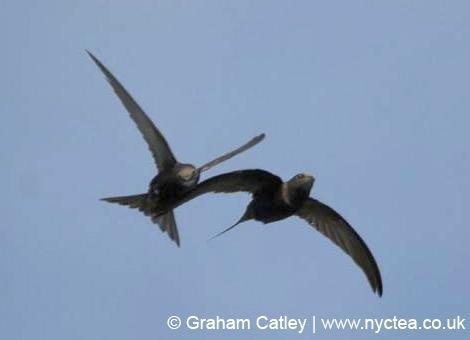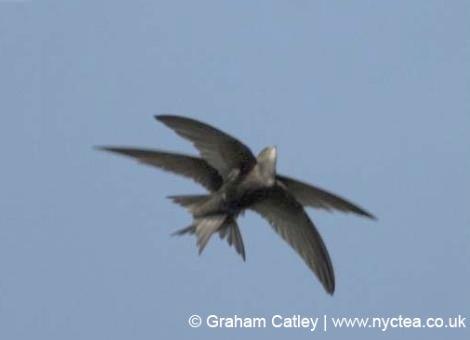
|
|
Aerial mating
|
|
With a bit of luck one can see Common Swifts mating in flight. This is a very quick event, it's over almost before one realises what is happening. DNA analyses taken from the colony at the tower of the Oxford University Museum showed that 4.5% of all Swift chicks tested were fathered by males who were not one of the nesting pair. As Swifts are highly aggressive to others who enter their nest sites, it is likely that these chicks result from aerial copulation. As far as we know, this behaviour is unique in the animal world.
For the first time, the aerial mating act was photographed. The following photos are published on the International Common Swifts Website with kind permission of the photographer Graham Catley.
The pre-flying female shows her readiness for copulation by putting her wings in a V-form
The tails of the protagonists help to vary the speed for the punctual meeting
The tails now move into the opposite direction which gives room for the cloaks to meet.
Finished? The couple lost some height during the activity and in a moment they will separate.
To see more pictures click on
http://www.commonswift.org/images.html (portraits and flight studies) To see a parent birds feeding a chick click here http://www.commonswift.org/colony_Kronberg.html |
Commonswift Worldwide © Ulrich Tigges
Apus apus, Swifts, Commonswift, gierzwaluw, vencejo comun, sis hachomot, סיס החומות, Црна чиопа, Kara Sağan, Čiopa, ciopa, chyorny strizh, Gierzwaluw (Apus apus), Vencejo común, Черный Стриж, Martinet noir, Rondone comune, rondoni, åtactara, السمامة, Mauersegler, Apuslife
Commonswift's topography, togography of the Commonswift, feathers, crown, eye line, eye patch, forecrown, lore, chin, throat, ear coverts, hindneck, mantle, scapulars, rump, uppertail coverts, tail, tertials, greater coverts, secondaries, median coverts, leading edge coverts, lesser coverts, lesser primary coverts, alula, median primary coverts, leading edge coverts, greater primary coverts, primaries, median coverts, greater coverts, secondaries, axillaries, undertail, undertail coverts, rear flank, vent, flank, belly, brest, apodidae, apodiformes, size, color, colour, weight, sex, flight acquaintance, flight speed, age, food, enemies, pair bonding, nest, eggs, egg, young, bad weather, voice, download wave file, survive, survival, colony, flying insects



